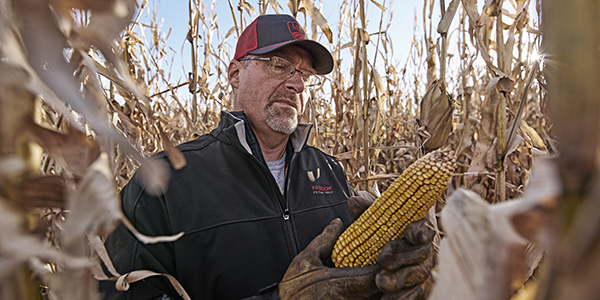AGRONOMICSUPPORT
YOU CAN TAKETO THE FIELD
Estimating Grain Yields Before Harvest
CORN:
Yields can be estimated pre-harvest by making predictions based on what are considered to be Yield Component Factors. This method is popular because it can be done well ahead of harvest, as early as the milk (R3) stage of kernel development. Under “normal” conditions, the kernel milk stage occurs about 18 to 22 days after pollination is complete.
The University of Illinois originally developed the Yield Component Method. They proposed that grain yield can be estimated by using the various factors that contribute to grain yield:
1) number of ears per acre
2) number of kernel rows per ear
3) number of kernels per row
4) weight per kernel.
All except weight per kernel can be obtained by scouting the corn field. Weight per kernel is the only factor that can't be accurately determined until the crop reaches black layer. However, it can be approximated by an average value for kernel weight. The industry-accepted factor used in estimations today is between 75-85, based on kernel size.
Random sampling is key to estimating yields. If the field is fairly uniform, fewer samples are needed. If the field is very non-uniform, more samples must be taken to furnish an adequate estimated yield.
The Method:
- Measure a length of row equal to 1/1000th acre. For 30-inch (2.5 feet) rows, this equals 17.4 feet.
- To calculate the distance for various other row spacing, use the formula: (43,560 / row space(in feet)) / 1000.
- Count and record the number of harvestable ears on the plants in that 1/1000th acre of row.
- Do not count dropped ears, or those on severely lodged plants (unless you can harvest the ears)
- For every fifth ear in the sample row, record the number of complete kernel rows per ear and average number of kernels per row. Then, multiply each ear's row number by the number of kernels per row to calculate the total number of kernels for each ear.
- Do not sample nubbins or poorly filled ears, unless they fairly represent the sample area. If row number changes from butt to tip (i.e. pinched ears due to stress), estimate an average row number for the ear. Don't count the extreme butt or tip kernels, but rather begin and end where you perceive there are complete "rings" of kernels around the cob. Do not count aborted kernels. If kernel numbers are uneven among the rows of an ear, estimate an average value for kernel number per row.
- Calculate the average number of kernels per ear by summing the values for all the sampled ears and dividing by the number of ears.
EXAMPLE:
For five sample ears with 510, 525, 445, 550, and 575 kernels per ear, the average number of kernels per ear would be (510 + 525 + 445 + 550 + 575) / 5 = 521.
Estimate the yield for each site by multiplying the ear number (Step 2) by the average number of kernels per ear (Step 4) and then dividing that result by the number from below that best represents the kernel set and grain fill conditions this year for the field whose yield you are estimating. The values below represent the range in numbers of kernels in a 56lb market bushel that correlates to growing conditions during grain fill and subsequent yield.

Calculation:
You counted 30 harvestable ears at the first thousandth-acre sampling site. Assume that the average number of kernels per ear, based on sampling every 5th ear in the sampling row, was 521. Assume that growing conditions during grain fill were average. The estimated yield for that site would (30 x 521) / 80, which equals 195.4 bushels /acre.
Repeat the procedure throughout field as many times as you deem to be representative. Calculate the average yield for all the sites to estimate the yield for the field.
SOYBEANS:
The same basic factors of yield can be estimated for soybeans to furnish pre-harvest yield estimates. Recognize that soybeans can greatly compensate for stress and also for favorable growing conditions.
Pod number, seeds per pod, and seed size are the driving forces of soybean yield. Purdue University has developed a “simplified” method for estimating soybean grain yields.
Key here is to again take random and representative samples. This technique allows for quickly scouting multiple areas of the field and is based on 1/10,000th acre and the following formula.
The Method:
- Count the number of pods in 1/10,000th of acre. Nearly 90% of soybean acres are planted in 30-, 15-, or 7.5-in rows. Count the number of pods in 1 row for 30-in width, 2 rows for 15-in width, or 4 rows for 7.5-in width to equal 1/10,000th acre. Each one of these counts will be 21 inches in length.
- Count the total number of pods in the 1/10,000th acre. Which pods to include in the count? It is suggested to count the pods that are greater than 1”, knowing that some the smaller pods may or may not develop.
- Seeds per Pod. The starting point is an average of 2.5 seeds per pod
- Soybeans can have a range of 1-, 2-, 3- or 4-seeded pods. This 2.5 value is conservative.
- You can quickly increase or decrease the yield estimate by changing this one value by remembering the frequency of 2- or 4-seeded pods within the pods you have counted.
- Seed Size Factor The starting point is seed size factor 18
- A fairly representative seed size is 3,000 seeds/pound. With expected larger seeds (excellent late season growing conditions), use a smaller seed size factor such as 15 (2,500 seeds per pound). Similarly, if seed is expected to be smaller (late season stress) use a larger seed size factor like 21 (3,500 seeds per pound).
Calculation:
PODS × SEEDS PER POD ÷ SEED SIZE FACTOR = ESTIMATED BUSHELS PER ACRE
EXAMPLES:
- Good soybean growth, good pod retention, and adequate late season moisture.
- 400 pods × 2.5 seeds per pod ÷ 18 = 55.5 bu/ac
- Good early soybean growth, fair pod retention, BUT little late season moisture.
- 300 pods × 2.5 seeds per pod ÷ 21 = 37.7 bu/ac
- Fair soybean growth, limited pod retention, BUT good late season moisture.
- 250 pods × 2.5 seeds per pod ÷ 15 = 41.7 bu/ac
Repeat the procedure throughout field as many times as you deem to be representative. Calculate the average yield for all the sites to estimate the yield for the field.
Remember: The weather during the end of the season will ultimately determine yield potential.
References used:
- http://www.agry.purdue.edu/ext/corn/news/timeless/YldEstMethod.htmlDr. RL (Bob) Nielsen, Purdue University
- https://www.purdue.edu/newsroom/releases/2013/Q3/formula-will-help-when-estimating-soybean-yield-potential.html Dr. Shaun Casteel, Purdue University
- https://www.agry.purdue.edu/ext/soybean/News/2012/2012_0814SOYSimplifiedYieldEstimates.pdf Dr. Shaun Casteel, Purdue University






Technical Team Agronomist Support